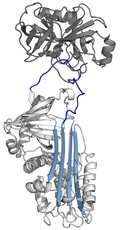Wikipedia:Today's featured article/April 2, 2016
Serpins are a superfamily of proteins with similar structures that were first recognized for their protease inhibition activity and are found in all kingdoms of life. Their unusual mechanism of action irreversibly inhibits their target protease by undergoing a large conformational change to disrupt its active site. This contrasts with the more common competitive mechanism for protease inhibitors that bind to and block access to the protease active site. Protease inhibition by serpins controls an array of biological processes, including coagulation and inflammation, and consequently these proteins are the target of medical research. Their conformational-change mechanism confers certain advantages, but it also has drawbacks: serpins are vulnerable to mutations that can result in protein misfolding and the formation of inactive long-chain polymers. Serpin polymerization not only reduces the amount of active inhibitor, but also leads to accumulation of the polymers, which can cause cell death and even organ failure. (Full article...)

